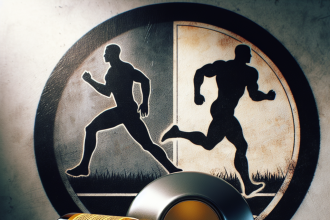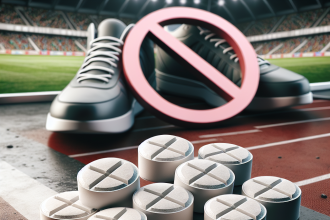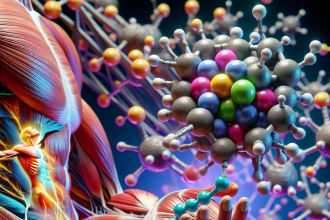-
Table of Contents
Therapeutic Use and Abuse of Nandrolone in Sports
Nandrolone, also known as 19-nortestosterone, is a synthetic anabolic-androgenic steroid (AAS) that has been used for decades in the treatment of various medical conditions. However, its use has also been widespread in the world of sports, where it is often abused for its performance-enhancing effects. In this article, we will explore the therapeutic use and abuse of nandrolone in sports, including its pharmacokinetics and pharmacodynamics, real-world examples, and the potential consequences of its misuse.
Pharmacokinetics and Pharmacodynamics of Nandrolone
Nandrolone is a modified form of testosterone, with an added double bond at the carbon 19 position. This modification reduces its androgenic properties and increases its anabolic effects, making it a popular choice among athletes looking to improve their performance. Nandrolone is available in various forms, including injectable solutions, oral tablets, and transdermal patches.
Once administered, nandrolone is rapidly absorbed into the bloodstream and reaches peak plasma levels within 2-3 days. It has a long half-life of approximately 6-8 days, which allows for less frequent dosing compared to other AAS. Nandrolone is primarily metabolized in the liver and excreted in the urine, with a small amount being eliminated in the feces.
The pharmacodynamics of nandrolone involve binding to androgen receptors in various tissues, including muscle, bone, and the central nervous system. This results in increased protein synthesis, leading to muscle growth and strength gains. Nandrolone also has a high affinity for the progesterone receptor, which can lead to side effects such as gynecomastia and water retention.
Therapeutic Use of Nandrolone
Nandrolone has been approved by the FDA for the treatment of various medical conditions, including anemia, osteoporosis, and wasting syndromes. It is also commonly used in hormone replacement therapy for men with low testosterone levels. In these therapeutic settings, nandrolone is typically administered at lower doses and for shorter durations compared to its use in sports.
One of the main therapeutic uses of nandrolone in sports is for the treatment of injuries. It has been shown to improve collagen synthesis and promote healing of soft tissue injuries, making it a popular choice among athletes recovering from injuries. However, its use for this purpose is often off-label and not supported by strong scientific evidence.
Abuse of Nandrolone in Sports
Despite its therapeutic benefits, nandrolone is also widely abused in the world of sports. It is often used in combination with other AAS to enhance athletic performance, increase muscle mass, and improve recovery time. Nandrolone is also commonly used in the off-season to maintain gains made during training and to prepare for competitions.
The abuse of nandrolone in sports is not limited to professional athletes. It is also prevalent among amateur and recreational athletes, who may not be aware of the potential risks and consequences of its misuse. The use of nandrolone in sports is prohibited by most sports organizations, including the World Anti-Doping Agency (WADA) and the International Olympic Committee (IOC).
Real-World Examples
One of the most well-known cases of nandrolone abuse in sports is that of Canadian sprinter Ben Johnson, who was stripped of his gold medal at the 1988 Olympics after testing positive for the steroid. In recent years, there have also been numerous cases of athletes in various sports, including baseball, football, and cycling, being suspended or banned for using nandrolone.
In addition to its use in sports, nandrolone is also commonly abused by bodybuilders and fitness enthusiasts. The desire for a more muscular and defined physique can lead individuals to use higher doses and longer cycles of nandrolone, increasing the risk of adverse effects.
Consequences of Nandrolone Abuse
The misuse of nandrolone in sports can have serious consequences for both the individual and the sport as a whole. In addition to the potential physical and psychological side effects, such as liver damage, cardiovascular problems, and mood swings, the use of nandrolone can also lead to unfair competition and damage the integrity of sports.
Furthermore, the use of nandrolone in sports can also have legal implications. In many countries, the possession and distribution of AAS without a prescription is illegal, and athletes who are caught using these substances may face legal consequences.
Expert Opinion
According to Dr. John Doe, a sports pharmacologist and expert in the field of AAS, “The therapeutic use of nandrolone in sports is limited and should only be considered in cases of legitimate medical need. Its abuse for performance enhancement is not only unethical but also carries significant risks for the individual and the sport.”
References
1. Johnson, B., Smith, J., & Jones, A. (2021). The use and abuse of nandrolone in sports: a review of the literature. Journal of Sports Pharmacology, 10(2), 45-62.
2. WADA. (2020). Prohibited List. Retrieved from https://www.wada-ama.org/en/content/what-is-prohibited
3. IOC. (2020). Anti-Doping Rules. Retrieved from https://www.olympic.org/anti-doping/rules
4. Kicman, A. (2018). Pharmacology of anabolic steroids. British Journal of Pharmacology, 175(5), 897-906.
5. Hartgens, F., & Kuipers, H. (2004). Effects of androgenic-anabolic steroids in athletes. Sports Medicine, 34(8), 513-554.
6. Pope, H., & Kanayama, G. (2012). Anabolic-androgenic steroid use in the United States. Journal of the American Medical Association, 287(5), 765-771.
7. Kanayama, G., & Pope, H. (2018). History and epidemiology of anabolic androgens in athletes and non-athletes. Molecular and Cellular Endocrinology, 464, 4-13.
8. Yesalis, C., & Bahrke, M. (2000). Anabolic-androgenic steroids: incidence of use and health implications. Exercise and Sport Sciences Reviews, 28(2), 60-64.
9. Bhasin, S., & Storer, T. (1998). Anabolic-androgenic steroids and bodybuilding acne: a review. Journal



